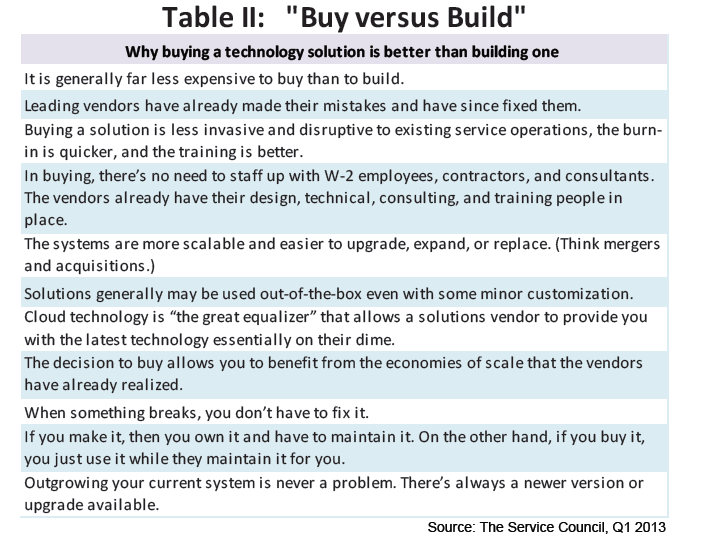We’ve reached the most exciting stop on the mobility train: implementation.
You’ve defined the problem, and brainstormed about ways to address this issue. Now – it’s time to make all these ideas come to life by meeting solution providers, designing a plan for implementing your solution in the business, and finally, getting the required buy-in to officially approve the mobile solution.
Start by exploring various technology to options that will support your business objectives. This is not the time at which you should decide on a particular vendor, but it can only be beneficial at this point to find out what problems can be solved through technology. Some of the solutions you have listed as process adjustments or perhaps even organizational changes are just possible solutions to problems that may be more affordably solved through technology. Vendors are in the best position to inform you about the extent of the capabilities they offer. And they have experience in helping organizations that have solved problems similar to or exactly like the ones you are currently facing.
At this time, it is also important to give consideration to the issue of “buy versus build.” However, in most cases, buying a technology solution will typically be better than building one in-house. The principal reasons are as follows (Table I):

After you have reviewed the various solution offerings, construct an outline containing your list of solutions as a chronological and integrated plan of attack.
- Organizational changes come first. The introduction or elimination of roles can have profound ripple effects within the department as well as externally. If you were to adjust processes before making organizational changes, such changes may be rendered irrelevant or even wasteful.
- Process adjustments are next. If the organizational structure is in order, it’s time to make the identified process adjustments. Ensure that new processes are being followed, closely monitor and measure results, and readjust as necessary. The management of processes is a process in itself, and as such, management should also readjust as necessary.
- Technology implementation follows. It is well-known that an organization should not fit itself to its technology solutions, but rather the technology solutions should fit the organization. However, that being the case, if the organization is not in order or if it is deficient in some way, a technology solution might not help, but instead may actually make things worse by reinforcing bad practices.
Once you’ve created the plan, work with other departments so as to facilitate interdepartment buy-in to the solutions that will be implemented. With their help, scrutinize the outlined plan, comparing and contrasting each solution as it relates to those that would be executed both before and after it chronologically. Among competing viable solutions, justify a winning solution in terms of how it better fits with the overall plan and how it better works toward achieving the goals you prioritized in the beginning of this process, and set aside other possible solutions. At this time, you should also know which path you’ve chosen in terms of technology, and if you’ve chosen to buy a Mobile Workforce Management Solution, you should have it in mind which vendor you would most like to work with.
Together with the help of other departments, you have built a solid plan to attain your goals and the overall business objectives. The process for gaining management buy-in is typically a multi-part, multi-departmental process that crosses over departmental boundaries and internal political thresholds. For most organizations, the primary focus will be on the financials or economics, of the proposed technology acquisition and implementation, specifically addressing the issues that management can best understand: What will it cost? What will be our anticipated ROI, and when will we begin to see results? To address these key management questions you and your technology acquisition team will need to provide management with a compelling argument based primarily on the financials, citing figures such as ROI, Break-Even, and Total Cost of Ownership.
In any case, you will need to present management with a thoroughly well-vetted case comprised of both the “hard numbers” as well as the “soft” factors that will also ultimately impact the bottom line in some fashion. Increased productivity, reduced costs, improved customer satisfaction, and the ability to offer a more expansive services product line are just a few examples. You will also need to do your due diligence in terms of matching solutions to needs, choosing the right vendor, and seeking the proper level of scalable technology that will carry your organization forward for years to come (supported with new releases, updates, support, etc.).
You will also need to fully document and compare the most practical alternatives, and be prepared to answer all of management’s questions. In order to do so, you will need to understand both the sensitivity and elasticity of your technology recommendation (i.e., in terms of what happens if you don’t move forward, or if you attempt to go the less expensive route, etc.). However, one thing that you will absolutely need to keep in mind at all times is that you may only get one shot at convincing management to move forward. You’ll need to be prepared, concise, compelling, persistent and resilient.
About Uniphore: Uniphore Technologies Inc is the leader in Multi lingual speech-based software solutions. Uniphore’s solutions allow any machine to understand and respond to natural human speech, thus enabling humans to use the most natural of communication modes, speech, to engage and instruct machines. Uniphore operates from its corporate headquarters at IIT Madras Research Park, Chennai, India and has sales offices in Middle East (Dubai, UAE) as well as in Manila, Philippines.
